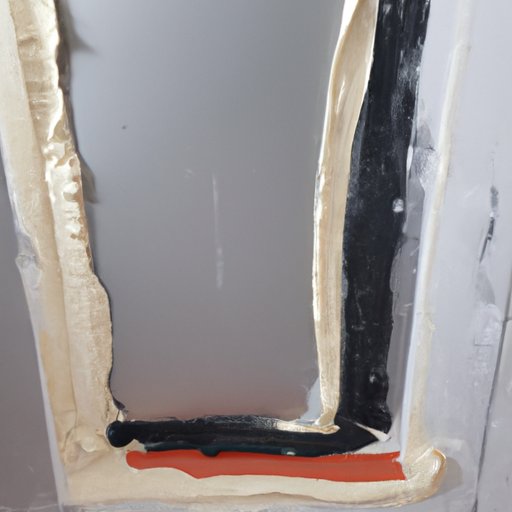
I. Introduction
As a homeowner or renter, you may find yourself needing to hang drywall or make repairs. However, when it comes to mudding drywall, it’s easy to feel overwhelmed and intimidated. Applying drywall mud, or joint compound, is a crucial step in creating a smooth and even surface for paint or wallpaper. Knowing how to mud drywall is an essential skill that will save you money and time and help you achieve a professional-looking finish. This article covers a beginner’s guide to mudding drywall, including step-by-step tutorials, tips and tricks, and essential equipment and techniques to master the art of drywall mudding.
II. A Beginner’s Guide to Mudding Drywall: Step-by-Step Tutorial
Before diving into the process of mudding drywall, it’s essential to set yourself up for success with proper preparation. Begin by taping all seams with drywall tape and ensure that the surfaces that will be mudded are clean, smooth, dry, and free from dust or debris.
To mix drywall mud, follow the instructions on the package. Be sure to start with a small amount and gradually add more water or mud until you reach the desired consistency.
Begin to apply the first coat of mud with a taping knife and work in long, uniform strokes. It’s essential to keep the coat thin, which will make the subsequent coats adhere better. Once the first coat is complete, let it dry completely before proceeding.
When applying subsequent coats of mud, use a wider knife, such as a 12-inch taping knife. Begin by feathering out the edges and gradually working toward the center. Take care not to overwork the mud, which can cause bubbles or cracks.
After the final coat of mud has dried, it’s time to sand it down. Using a fine-grit sandpaper, lightly sand the surface until it is smooth and even.
III. Tips and Tricks for a Flawless Drywall Mud Application
Choosing the right type of mud is crucial to achieving a flawless finish. Consider using setting compound for the first coat, which dries more quickly and is easier to sand.
A taping knife is the most critical tool for applying drywall mud. For better application, use the proper technique, and use the knife to apply even pressure while feathering the mud. Avoid common mistakes such as over-sanding, which can damage the surface, or adding too much water to the mud, which can cause it to crack.
For a surface that is free of bubbles and cracks, it’s essential to let the mud dry completely between coats and avoid overworking it.
IV. Mastering the Art of Drywall Mudding: Essential Equipment and Techniques
Here’s a list of the essential tools for mudding: a taping knife, a joint compound pan, sandpaper, drywall tape, and a hand sander.
Techniques for a smooth finish include feathering out the edges, avoiding overworking the mud, and floating the edges of the surface with a wider knife. When working around corners and edges, take extra care to avoid leaving ridges or bumps.
To work with screws, use the knife to apply mud around the screw holes, then use a sanding block to smooth the surface.
V. Common Drywall Mud Mistakes (and How to Avoid Them)
One of the most common mistakes made while mudding drywall is not properly ventilating the room. Ensure that the space has adequate ventilation, or the mud may take longer to dry and cause mold and mildew to form.
Another mistake is overworking the mud, leading to bubbles or cracks. Ensure that each coat of mud is dried completely before proceeding with the next, and avoid adding too much water to the mixture.
VI. The Importance of Sanding in Drywall Mudding: Expert Advice
Sanding is an essential step that should not be skipped as it helps to create a smooth and even surface. Begin with a coarse-grit sandpaper and gradually work your way up to a fine-grit sandpaper.
When sanding, take care not to sand too much, as it can damage the surface. Be sure to follow safety precautions and wear a mask to avoid inhaling dust. After sanding, it’s crucial to properly clean up the area to avoid leaving any dust on the surface.
VII. Hacks for Speeding Up Your Drywall Mud Process
If you’re short on time, there are shortcuts that you can take without sacrificing the quality of the finish. For instance, consider using a setting compound for the first coat of mud, which dries more quickly.
Another method is to use a roller to apply the mud rather than a taping knife. This technique can produce a good result in less time.
However, it’s important to remember that while speeding up the process is helpful, it’s still crucial to apply the mud correctly to avoid common mistakes such as over-sanding or overworking.
VIII. Experimenting with Textures: Drywall Mud Techniques for Unique Designs
Drywall mud can be used to create a variety of textures and designs. Consider experimenting with swirls, stippling, or other designs to add depth and uniqueness to your walls.
Choose the right type of mud for each design, such as a heavyweight mud for deeper textures. Techniques for creating textures include using a sponge, a roller, or a texturing tool.
IX. Conclusion
Mudding drywall may seem daunting, but with these tips, tricks, and techniques, you can achieve a professional-looking finish. Remember to properly prepare, use the right tools, and take your time to avoid common mistakes. By experimenting with textures and designs, you can create a unique and personalized look for your walls. Practice and patience are key, so don’t be afraid to try new techniques and have fun!
Lastly, be sure to properly clean up after mudding and sanding, as dust and debris can cause further damage to the surface. With these essential skills under your belt, you can tackle any drywall project with confidence and ease.




